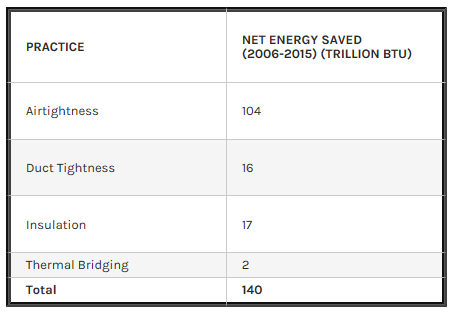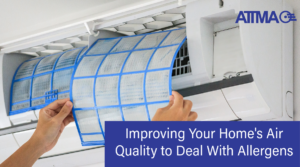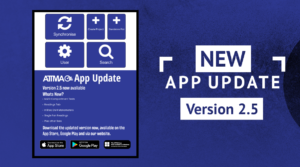The Building Technologies Office (BTO) recently released Evaluation of Building America and Selected Building Energy Codes Program Activities, a retrospective benefit-cost analysis conducted by Industrial Economics (IEc) that quantifies the impact of selected Building America activities in the new residential construction market. Findings showed that Building America’s efforts reduced America’s energy costs and improved its environmental health by a combined $875 million over the past 10 years, at a total program cost of only $162 million – a 30.2% internal rate of return on BTO’s investment.
At the start of this evaluation IEc interviewed building science experts to help scope the study; this ultimately focused the evaluation on four energy-efficient building practices from Building America’s portfolio: airtightness, duct tightness, envelope insulation, and thermal bridging. To measure the impact of these energy-efficiency practices IEc used a variety of different evaluative methods – including expert interviews, computer modeling, and publication citation analyses.
The evaluation team used DOE’s Building Energy Optimization (BEopt) software to calculate how much energy these practices saved. However, Building America was not the only initiative promoting these practices, so the evaluators asked an independent panel of experts to estimate the portion of energy savings that could be attributed to Building America’s efforts rather than other rival factors.
Ultimately, the study found that Building America’s four selected building practices saved Americans 140 trillion BTUs of energy and $689 million in energy cost savings from 2006 to 2015 – and provided an additional $186 million in benefits from avoided negative health impacts. Notably, improved air tightness practices represented almost 75% of these savings.
| Practice | Net Energy Saved (2006-2015) (Trillion BTU) |
|---|---|
| Airtightness | 104 |
| Duct Tightness | 16 |
| Insulation | 17 |
| Thermal Bridging | 2 |
| Total | 140 |
Because some of the benefit identified through this approach are linked to improvements in Building Energy Code – and BTO has an entire program focused on the development, adoption, and compliance of building energy codes – IEC gathered data and interviewed key stakeholders that would help explain the role BTO’s Building Energy Codes program played in code development. They found that the 2009 and 2012 International Energy Conservation Codes (IECC) would have produced weaker building energy efficiency standards, thus delaying home efficiency improvements; this is especially true given that the 2009 IECC provided the first major energy code improvement in 20 years.
Despite its large analytical scope, the report’s findings almost certainly underestimate the full value of Building America, as only a selection of Building America’s 20+ years of projects and activities were studied. The benefits of other Building America innovations – like a vapor retarder classification system, more accurate climate maps, and moisture management practices that help prevent mold growth in homes – were not quantified in this analysis, but both builders and building science experts highlighted these practices as impactful. Further, homes last for a long time, and since the benefits considered in this analysis only cover the period 2006-2015, this means that they will continue to enhance building energy performance for many more years to come. When IEc incorporated the value of these future benefits, or the homes’ remaining “useful life,” the internal rate of return jumped to 32.4%, and the net-present value of avoided energy costs and environmental benefits increased from $713 million to $2.3 billion.
Beyond monetizing Building America’s impact, the report also strove to evaluate the influence Building America has had on the American building industry’s understanding of building science. Overall, IEc found over 300 articles across 15 trade journals that referenced Building America or the technologies and practices the program advanced – and air-sealing, air barriers, and insulation were the most frequent topics, which confirmed the Building America’s theory of change.
Overall, this report offers strong evidence that Building America’s investments have advanced the American homebuilding landscape while yielding significant dividends for taxpayers. Current Building America projects continue to “push the envelope” through research, field testing, and the verification of new technologies and systems for residential buildings, to save energy and dollars on American energy bills.
Author: Jack Mayernik
Jack Mayernik works for the National Renewable Energy Laboratory’s Strategy Energy Analysis Center and supports the Building Technologies Office.





